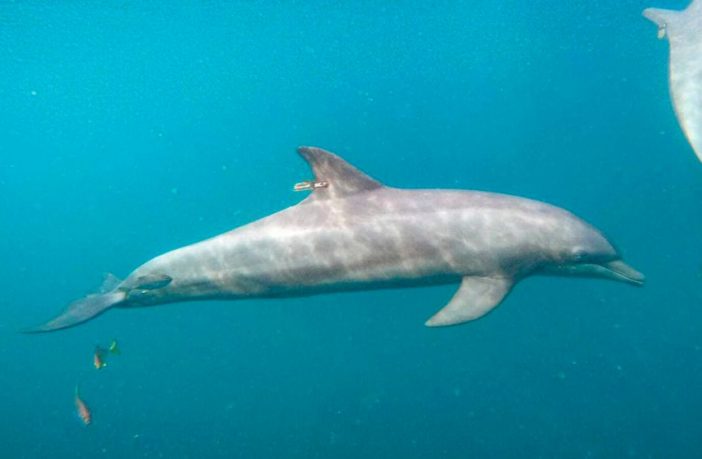
TOKYO– Three bottlenose dolphins were released into the open sea in Indonesia on Saturday after years of confinement to the delight of tourists who touched and swam with them.
As the red and white Indonesian flags flew, underwater doors opened off the island of Bali to allow Johnny, Rocky and Rambo to swim freely.
The trio were rescued three years ago from their small pool at a resort hotel to which they had been sold after spending years performing in a traveling circus.
They regained their health and strength at the Bali Sanctuary, a floating enclosure in a bay that provided a gentler, more natural environment.
Lincoln O’Barry, who worked with the Indonesian government to establish the Umah Lumba Rehabilitation, Release and Retreat Center, said dolphins are wild animals that should live in the wild.
“It was an incredibly moving experience to watch them go,” O’Barrry said.
The center was launched in 2019 by the Bali Forest Department and the Indonesian Ministry of Forests. “Umah lumba” means “dolphin” in Indonesian.
For some time after the gates opened, the dolphins watched the opening, unsure of their next move. But after about an hour they were on their way, sometimes jumping over choppy waves.
The Associated Press watched their release via an online livestream. O’Barry documents the outing with drones and underwater footage for a movie.
The Indonesian government supported the dolphin rescue, working with the Dolphin Project, founded by Lincoln’s father, Ric O’Barry, who was also on the outing.
Ric O’Barry had been the dolphin trainer for the 1960s TV show “Flipper,” but came later to see the toll imposed on the animals. He has since dedicated his life to bringing dolphins back into the wild.
Center employees cheered as the dolphins swam away. Wahyu Lestari, rehabilitation coordinator at the center, said she was a little sad to see them go.
“I’m happy they’re free and going back to their families,” she said. “They should be in the wild because they were born in the wild.”
The released dolphins will be tracked at sea with GPS tracking for a year. They may return for visits to the shrine, although it is unclear what they will do. They can join another group, stay together or split up.
Dolphins in captivity are transported from town to town, kept in chlorinated water, held in solitary confinement or forced to interact with tourists, often resulting in injury.
Johnny, the oldest dolphin, had teeth worn down to below the gum line when he was rescued in 2019. Earlier this year, dentists provided him with dolphin-style dental crowns so he can now suppress living fish.
Johnny was the first of three dolphins to swim out to sea.
Ric and Lincoln O’Barry have spent half a century rescuing dolphins from captivity in places from Brazil to South Korea and Saturday’s release in the United States was their first in Indonesia.
The Indonesian government’s decision to save the dolphins follows a decade-long public education campaign that included billboards, artwork, school curricula and a campaign asking people not to buy dolphins. tickets for dolphin shows.
A government minister was on hand to lift the gate to the shrine on Saturday.
Lincoln O’Barry said the Indonesian sanctuary will continue to be used for other captive dolphins. Similar sanctuaries are in the works in North America and Europe, as more dolphin shows draw closer. With virtual reality and other technologies, nature appreciation doesn’t necessarily involve a zoo or a dolphin show, he said.
Yet dolphin shows are still popular in China, the Middle East and Japan.
In Japan, father and son have drawn attention to the hunt for dolphins in the town of Taiji, documented in the 2010 Oscar-winning film “The Cove”. Each year, fishermen scare and round up the dolphins in a creek, capturing some to sell at dolphin shows and killing others for food.
Whale and dolphin meat is considered a delicacy in Japanese culinary tradition. But Taiji has drawn protests from conservationists for years, including some Japanese.
The three dolphins released in Indonesia soon found themselves kilometers (miles) in the waters. But before they left, they walked around the sanctuary.
“They turned around and came back to us once again, almost to say thank you and goodbye. And then they headed straight for the open ocean and disappeared,” Lincoln O’Barry said.
“Where they’re headed next, we don’t know. But we wish them a good long life.
———
Yuri Kageyama is on Twitter https://twitter.com/yurikageyama
ABC News




